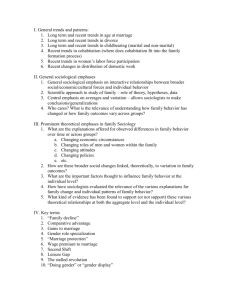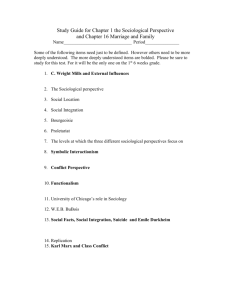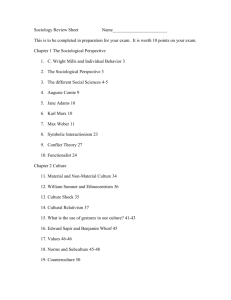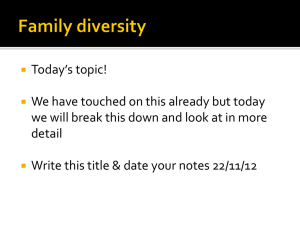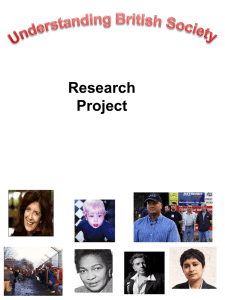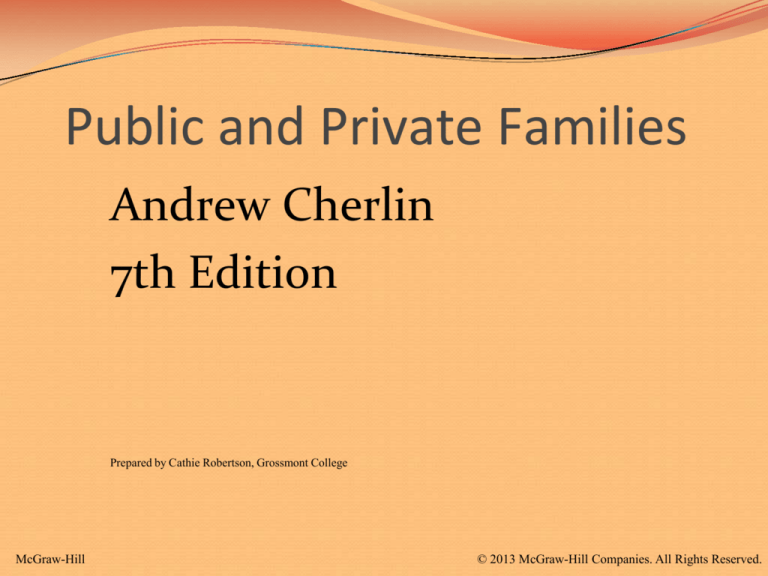
Public and Private Families
Andrew Cherlin
7th Edition
Prepared by Cathie Robertson, Grossmont College
McGraw-Hill
© 2013 McGraw-Hill Companies. All Rights Reserved.
Chapter 1
Public and Private Families
1-2
Marriage and Individualism
On one hand, marriage-centered family life
remains the preference
On the other, there is much more toleration
for family life without the boundaries of
marriage, and the idea to never marry is
acceptable
1-3
Marriage and Individualism (cont.)
Individualism Pursuing own interest and
priority is on developing a personally
rewarding life
Utilitarian Individualism: Puts emphasis
on self-reliance and personal achievement
Expressive Individualism: Places emphasis
on developing one’s feelings and emotional
satisfaction
1-4
Marriage and Individualism (cont.)
Although most Americans want to marry,
they feel less of a need to do so today
Marriage may compete with staying in
school, developing a career, cohabitating, or
having children outside of marriage
1-5
Figure 1.1
Percentage of Adults answering “very important” to the following values
1-6
What is a Family?
Social Conservative definition—only one
“correct” family
Two parent breadwinner-homemaker
family is the only acceptable form
Economic definition—specific rules
about who qualifies to be a family
member
Only those that “qualify” are eligible for
benefits
• Cultural definition—varies from culture
to culture
1-7
What is a Family? (cont.)
Two key questions about public
responsibilities and private pleasures of a
family
1. How well are families taking care of
children, the frail elderly, and the ill?
2. How well are families providing emotional
satisfaction that people value?
1-8
The Public Family
Definition of the “Public Family”: One
adult or two adults who are related by
marriage, partnership, or shared
parenthood who is/are taking care of
dependents, and the dependents
themselves
1-9
The Public Family (cont.)
Cost and Benefits
Externalities: Costs or benefits that
accrue to others when an individual or
business produces something
1-10
The Public Family (cont.)
Negative externalities: Costs
imposed when an individual or
business produces something of
value to itself
Positive externalities: Benefits
received by others when an
individual or business produces
something that is not fully
compensated for to that business or
individual
1-11
The Public Family (cont.)
Public Goods
Things that might be enjoyed by people who
did not pay for or produce themselves
Children might be considered a public good
Look to Social Security as an example
1-12
The Public Family (cont.)
Families “produce” children
Families care for young, poor, and
elderly
By performing these tasks they are
saving the public funds it would cost to
do so
1-13
The Public Family (cont.)
The free-rider problem
Tendency for people to obtain public goods
by letting others produce the goods that they
enjoy—like a free ride on the back of another
1-14
The Private Family
“Private Family”: Two or more
individuals who maintain an intimate
relationship that they expect will last
indefinitely or, in the case of parent and
child, until the child reaches
adulthood—and who live in the same
household and pool their income and
household labor
1-15
The Private Family (cont.)
Provides intimacy, emotional support, and
love
This is where children first form attachments,
teenagers take steps toward independence,
and adults share inner selves with someone
else
1-16
The Private Family (cont.)
Kinship ties from the Private Family
Created kinship—have been constructed
Assigned kinship—have been acquired
1-17
Two Views, Same Family
Both the public and private perspective
could apply to the same family unit
There are two ways to look at the
institution of the family
1-18
How Do Family Sociologists Know What
They Know?
Look at the family with
objectivity—this allows
conclusions to be drawn in a social
situation that are unaffected by
one’s own beliefs
Scientific method – “systemic
organized series of steps that
ensures maximum objectivity and
consistency in researching a
problem”
1-19
How Do Family Sociologists Know What
They Know? (cont.)
Essence of scientific method forms a
hypothesis—a speculative statement
about the relationship between two or
more variables
1-20
How Do Family Sociologists Know What
They Know? (cont.)
Rarely possible for sociologists to
conduct randomized experiments on
families
Research is generally done by one of two
methods:
Survey: A study in which individuals
from a geographic area are selected,
usually at random, and asked a fixed set
of questions
Observational study: A study in which
the researcher spends time directly
observing each participant
1-21
How Do Family Sociologists Know What
They Know? (cont.)
National Surveys
Larger
Use in-person interviews
Are longitudinal (interview conducted several
times at regular intervals)
Intended to be public resources
Conducted by academic researchers
1-22
Sociological Theory and Families
Methods and questions used by sociologists
are influenced by sociological theory
We will be looking at four perspectives of
theories
Exchange Perspective
Symbolic Interaction Perspective
Feminist Perspective
Postmodern Perspective
1-23
Exchange Perspective
Exchange theory
Women exchange performance of household
and childcare services in return for benefit of
men’s income
Men perform outside labor in exchange for
household and childcare services performed
by women
When women earn money on their own,
their dependence decreases and husbands’
power over them decreases
1-24
Symbolic Interaction Perspective
Symbolic interaction theory
We interpret symbols of how people act
Shared understandings of how people should
act create the basis of social roles that people
play
1-25
Feminist Perspective
Feminist theory
Gender defines social roles and cultural
characteristics
These roles have no biological reason-culturally dictated; socially constructed
These roles appear to be constructed to give
men power
Experience of living in a family is different for
women than it is for men
1-26
The Postmodern Perspective
Personal life has changed fundamentally
over the last several decades
Modern era—mid-19th century to mid-to-
late 20th century
Late modern era began mid-to-late 20th
century aka Postmodern era
In the modern era, individuals moved
through a series of roles (student, spouse,
parent, housewife, breadwinner) that
seemed more or less natural
1-27
The Postmodern Perspective (cont.)
In the Postmodern era, individuals must
make choices about nearly all aspects of
their lives
These include whether or not to get married,
have children; not necessarily both
Self-identity: A person’s sense of who he or
she is and where he or she fits into the social
structure.
Reflectivity: The process through which
individuals take in knowledge, reflect on it, and
alter their behavior as a result
1-28
Globalization and Families
“Globalization”: The increasing flow of
goods and services, money, migrants,
and information across the nations of
the world
1-29
Globalization and Families (cont.)
• Globalization has affected family life,
though differently for Western and
developing nations.
• Developing Nations
• Creation of millions of low-wage
jobs
• Women working outside the
home gain independence
• Childcare needs
• Western Nations
• Difficult for high schooleducated adults to find jobs
• Delaying marriage
1-30
A Sociological Viewpoint
on Families
Author believes
families perform services of value to
society and should be publicly supported
when necessary
despite diversity, families still are worth
studying
stable long-term partnerships, regardless
of sexual orientation, provide the best
environment for raising children
1-31
A Sociological Viewpoint on
Families (cont.)
Alternative family forms with adequate
support can provide good environments for
children
In equality of men and women in family life
In using the singular form “family” when
discussing the family as a social institution
where there is a set of roles and rules that
define a social unit of importance to society
1-32

